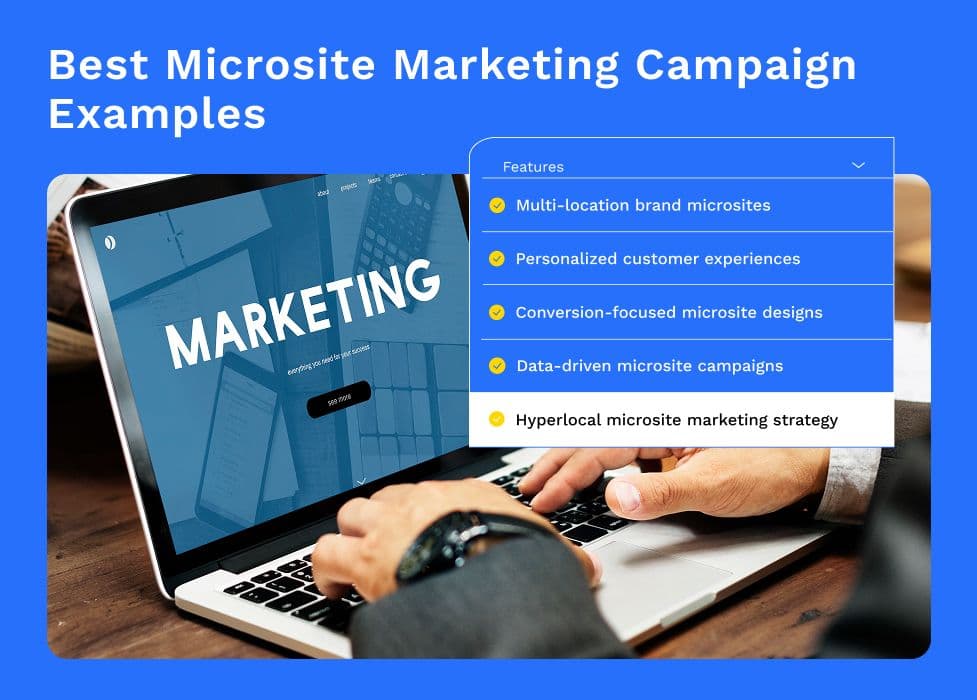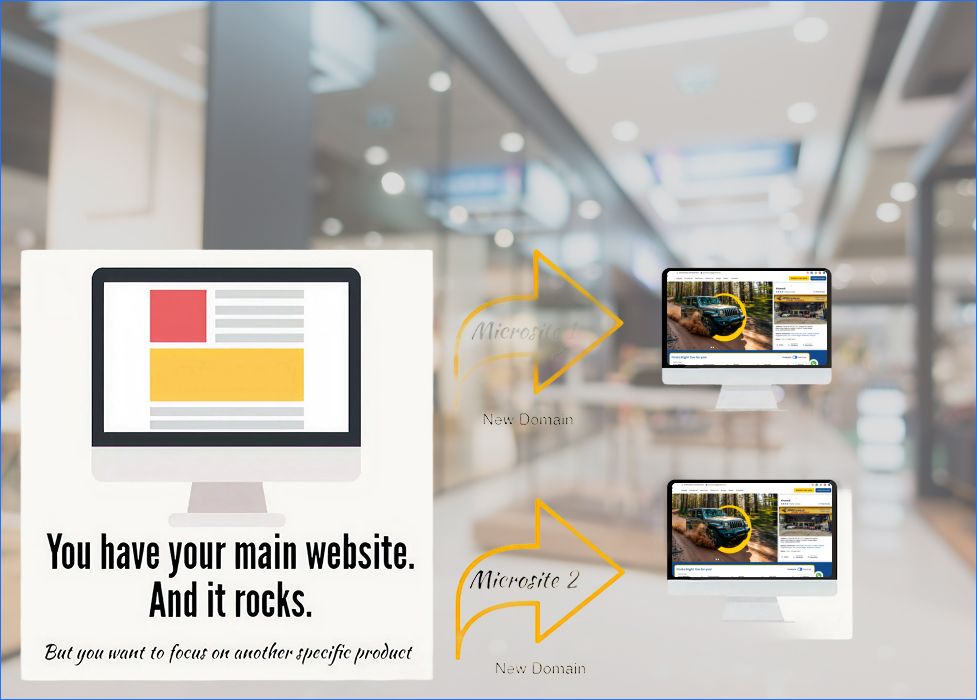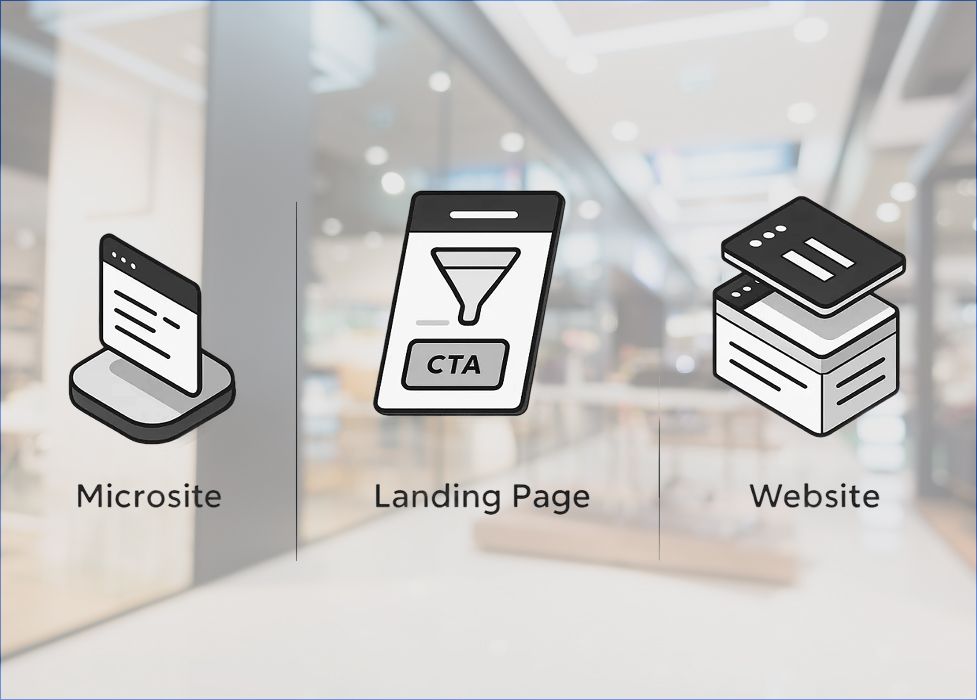Microsite
10 Best Microsite Marketing Campaign Examples in 2025
Fri, 05 Apr 2024 08:59:03 GMT
Speak to our Hyperlocal Expert

Editor’s Note: This post was originally published in Apr 2024 and is updated in Nov 2025 for accuracy and comprehensiveness.
Microsite marketing creates small, focused websites for specific products or campaigns, engaging a particular audience. With unique design and content, it enhances brand visibility and encourages actions, contributing to the overall marketing strategy.
In 2025, microsite marketing is a potent strategy, with businesses using small, focused websites to promote products and engage specific audiences. This guide explores the importance and advantages of microsites, outlines key elements for effectiveness, and presents real-world examples of successful campaigns. It delves into how businesses can use microsites for localised marketing and sales, addresses common challenges, and offers solutions.
What Is A Microsite?

A microsite is a focused online platform created to promote a company’s products, services, campaigns, or brand initiatives. It functions as a separate website or web page with its own domain or subdomain, distinct from the main company site. In microsite marketing, these compact platforms play a crucial role in delivering highly targeted and engaging content that supports specific business goals.
Boost your brand visibility with microsite campaigns designed for precise audience engagement. Unlike standard web pages, microsite marketing campaigns allow brands to go deeper into storytelling, highlight individual products or events, and build stronger user connections through personalised experiences.
Whether short-term or long-term, using microsites for marketing helps brands reach niche audiences effectively. For instance, businesses with multiple locations can create dedicated microsites for each branch, allowing for localised digital marketing campaigns that attract the right audience with hyper-targeted messaging.
Importance and Advantages of Microsite Marketing
Microsite marketing is a powerful way for brands to create focused, high-converting digital experiences. Unlike full websites that serve broad audiences, microsites let businesses deliver targeted campaigns, promote specific products, and connect with local audiences more personally. When used strategically, a microsite campaign can boost engagement, lead generation, and conversions.
For brands managing multiple locations or products, using microsites for marketing enables localised content delivery and stronger audience relevance. Whether it’s a product launch, regional offer, or event, microsite marketing campaigns help brands communicate specific messages that drive results.
Key Advantages of Microsite Marketing -
- Focused Campaign Messaging: Microsites highlight specific goals like a promotion or event without diluting the main brand message.
- Local and Personal Engagement: Perfect for hyperlocal marketing, microsites allow content tailored to regional audiences. With Sekel Tech’s tools, brands can create localised microsites that increase visibility and store visits.
- Better SEO and Discoverability: Targeted keywords and location-specific optimisation help microsite campaigns rank higher in search, improving online visibility.
- Higher Conversions: Focused CTAs and streamlined layouts make microsite marketing ideal for boosting inquiries, bookings, and sales.
- Performance Tracking and Insights: Using tools like Sekel Tech’s analytics dashboard, businesses can track performance, analyse engagement, and refine microsite marketing campaigns in real time.
In essence, microsite marketing helps brands run more agile, measurable, and localised campaigns. With Sekel Tech’s platform, businesses can easily build and manage microsites that connect online engagement with offline results, driving stronger digital-to-physical impact.
Microsite vs Website vs Landing Page: Key Differences Explained

Aspect | Microsite | Website | Landing Page |
| Purpose | Dedicated to a campaign or product | Main digital hub covering entire business | Focused on a single offer or action |
| Content Scope | Limited, targeted, 3-10 pages | Broad, many pages, full brand story | Very minimal, one goal-oriented page |
| Design & SEO | Tailored design with niche keyword SEO | Full brand design, keyword-rich across topics | Simple design, mainly conversion-driven |
| User Journey | Explore campaign details, engage | Discover brand, browse many products | Arrive → act, minimal other distractions |
| Ideal Use Case | Product launches, local campaigns | Brand presence, full e-commerce site | Ads, lead generation, flash sales |
Watch this quick video to understand the core differences between a microsite and a landing page and how retail brands can use each effectively. "Microsite Vs Landing Page: Which is Best for Retail Brand?"
Key Elements of an Effective Microsite Marketing Campaign

Here are the essential elements that make a microsite marketing campaign effective and high-performing:
1. Compelling Visual Design
Visual appeal is key to a successful microsite marketing strategy. The microsite should have a cohesive and engaging design that aligns with the brand while capturing visitor attention. Use high-quality images, clean layouts, and interactive visuals to make your microsite campaign stand out.
2. Targeted and Relevant Content
Create content that’s tailored to the microsite’s purpose and target audience. Keep the messaging concise, relevant, and engaging. Using microsites for marketing allows brands to deliver focused content such as videos, infographics, or interactive tools that enhance the user experience and improve conversions.
3. User-Friendly Navigation
An effective microsite marketing campaign should offer intuitive and straightforward navigation. Visitors should easily find what they’re looking for through a clear structure, simple menus, and compelling calls-to-action that guide them toward conversions.
4. Mobile Responsiveness
With most users accessing content on smartphones, mobile optimisation is essential. Ensure your microsite marketing design adjusts seamlessly to all devices, providing a smooth browsing experience that keeps users engaged.
5. Search Engine Optimization (SEO)
Optimise the microsite for search engines by using relevant keywords, structured data, and optimised meta tags. This enhances visibility, helping your microsite campaign appear in relevant search results and drive more targeted traffic.
6. Integration with Main Website
If your microsite complements a larger website, ensure smooth integration for consistent branding. This helps users transition seamlessly between your main site and the microsite marketing campaign, strengthening brand trust and continuity.
7. Measurable Goals and Analytics
Define clear KPIs for your microsite marketing campaign - such as traffic, engagement, conversions and track them through analytics tools. Platforms like Sekel Tech’s analytics dashboard can help businesses measure performance in real time and refine strategies effectively.
8. Social Media Integration
Connect your microsite marketing efforts with social media. Add share buttons and links so users can easily promote your content, expanding reach and engagement across digital channels.
9. Clear Calls-to-Action (CTAs)
Guide visitors with strong CTAs that drive action - whether it’s signing up, purchasing, or learning more. Effective CTAs are essential for achieving the goals of your microsite campaign.
10. Regular Updates and Maintenance
Keep your microsite marketing fresh and up to date. Regularly refresh content, fix broken links, and review performance metrics. A well-maintained microsite reflects professionalism and builds long-term trust.
By incorporating these key elements, brands can build powerful microsite marketing campaigns that attract the right audience, deliver value, and drive measurable business results.
Read Also - Strategic Microsite Lead Generation: Boost Your Conversion
What Are the Benefits of Creating a Microsite?
Creating a microsite is one of the most effective ways to launch focused and high-performing microsite marketing campaigns. Unlike a full-fledged website, a microsite campaign zeroes in on specific goals such as product launches, localised offers - helping brands connect with audiences at a deeper, hyperlocal level. With platforms like Sekel Tech, businesses can seamlessly create, manage, and optimise microsites for marketing, empowering them to deliver personalised content, boost engagement, and drive measurable conversions
1. Localised Content That Builds Stronger Connections
With microsite marketing, brands can design content that resonates with specific local audiences. Tailoring promotions, visuals, and offers to match local interests enhances the relevance of each microsite campaign, driving more engagement and trust within the community.
2. Targeted and Flexible Campaigns
A microsite marketing campaign gives businesses the flexibility to focus on local events, seasonal promotions, or store-level campaigns. This makes using microsites for marketing a powerful tool for testing new ideas, analysing real-time data, and refining future strategies.
3. Improved Local SEO and Online Visibility
When optimised with local search keywords, microsite marketing campaigns can boost visibility in regional search results. Each microsite can rank independently, helping retailers capture nearby audiences searching for location-specific products or services.
4. Builds Credibility Through Local Engagement
Using microsites for marketing allows brands to showcase authentic customer stories, local testimonials, and partnerships. This not only strengthens brand credibility but also reinforces community trust - a key pillar of any successful O2O marketing strategy.
5. Enhanced User Experience and Higher Conversions
A well-structured microsite marketing campaign provides a smooth user experience through mobile optimisation, interactive maps, and exclusive local offers. These features improve engagement, encourage offline visits, and increase conversion rates across both online and offline channels.
In summary, leveraging microsite marketing with Sekel Tech’s microsite management platform enables brands to create hyperlocal, conversion-focused campaigns that align with their larger online to offline (O2O) strategy. By integrating local SEO, personalised experiences, and real-time conversion analytics, businesses can enhance brand visibility, strengthen customer engagement, and achieve stronger returns from every microsite campaign.
10 Best Microsite Marketing Campaign Examples

1. Microsite Campaign Example: Kalyan Jewelers Microsite
Kalyan Jewelers captivates visitors with a dedicated microsite, powered by Sekel Tech, showcasing its latest Diamond Jewellery collection. The microsite utilises stunning visuals and engaging content to highlight the intricate designs and craftsmanship of the jewellery, creating an immersive experience for users interested in the latest trends and styles in diamond jewellery.
2. Microsite Campaign Example: Bridgestone Microsite
Bridgestone's microsite, powered by Sekel Tech, stands out by delivering a personalised experience to users. Through tailored content and user-centric features, the microsite establishes a strong connection with visitors, fostering a sense of personalization and driving a deeper connection between the brand and its audience.
3. Microsite Campaign Example: HP Microsite
HP's tech-savvy microsite, powered by Sekel Tech, showcases the features of its new laptops. The microsite provides an immersive experience for tech enthusiasts, offering in-depth insights into innovative technologies. HP engages its audience through interactive elements and rich multimedia, creating excitement around its cutting-edge products.
4. Microsite Campaign Example: Schneider Electric Microsite
Schneider Electric's narrative-driven microsite, powered by Sekel Tech, spotlights its latest product, emphasising the brand's commitment to innovation and sustainability. The microsite effectively communicates the product's journey and features in a compelling way, captivating the audience with a storytelling experience.
5. Microsite Campaign Example: VLCC Microsite
VLCC's educational microsite, powered by Sekel Tech, informs users about advanced courses. The microsite utilises engaging content and interactive features, providing an informative and enriching experience for visitors interested in wellness and beauty education. Leveraging the microsite for educational engagement strengthens VLCC's brand authority in the wellness industry.
6. Microsite Campaign Example: Greenply Microsite
Greenply's sustainability-focused microsite, powered by Sekel Tech, showcases eco-friendly wood solutions. The microsite educates visitors on the environmental benefits of Greenply products, contributing to brand credibility and consumer awareness in the context of sustainable choices.
7. Microsite Campaign Example: Grohe Microsite
Grohe's comprehensive bathroom solutions microsite, powered by Sekel Tech, offers a user-friendly interface and visually appealing presentations. The microsite guides visitors through a diverse range of products, showcasing the brand's expertise in delivering holistic bathroom solutions, serving as a one-stop destination for consumers exploring innovative designs.
8. Microsite Campaign Example: Kohler Microsite
Kohler's cutting-edge design microsite, powered by Sekel Tech, highlights innovative features in home and bathroom solutions. The microsite employs visually striking elements and interactive showcases to emphasise the brand's commitment to innovation and aesthetics, providing users with a sophisticated digital experience.
9. Microsite Campaign Example: American Standard Microsite
American Standard's wellness-focused microsite, powered by Sekel Tech, enhances consumer knowledge about wellness products. The microsite serves as a valuable resource with detailed information, user testimonials, and interactive features, positioning American Standard as a trusted authority in the wellness industry.
10. Microsite Campaign Example: Naturals Ice Cream Microsite
The Naturals Icecream limited-time menu microsite, powered by Sekel Tech, strategically promotes exclusivity. Through visually appealing content and clear calls to action, the microsite effectively communicates the uniqueness of the menu item, encouraging users to explore and make timely purchases.
Get a clearer picture by watching this concise video “Best Microsite Marketing Campaign Examples in 2025”.
Common Challenges in Microsite Marketing and Solutions
Here are common challenges in microsite marketing along with potential solutions:
Challenges | Solutions |
| SEO Dilution | Use unique keywords, optimise content, and cross-link with the main website to maintain SEO strength. |
| Audience Confusion | Keep navigation intuitive and content structure consistent across all microsites. |
| Mobile Responsiveness | Design with a mobile-first approach to ensure seamless viewing on all devices. |
| Content Quality Control | Set style guides, approval workflows, and conduct regular content audits. |
| Data Security | Use secure hosting, SSL encryption, and perform regular security checks. |
| Tracking & Analytics | Integrate unified analytics tools for real-time tracking and performance insights. |
| Integration with Main Website | Maintain cohesive branding, shared navigation, and cross-links for a unified experience. |
By addressing these challenges with strategic planning and effective solutions, businesses can optimise their microsite marketing efforts and enhance overall success.
How to Start Microsite Marketing for Your Retail Outlets?
Initiating Microsite Marketing for your Retail Outlets involves a strategic approach to enhance visibility, engagement, and sales. Here's a step-by-step guide to help you get started:
1. Define Objectives
Clearly outline your goals for Microsite Marketing. Whether it's increasing foot traffic, promoting specific products, or improving brand awareness, having well-defined objectives will guide your strategy.
2. Identify Target Audience
Understand your target audience's demographics, preferences, and behaviours. This information will shape your content and marketing efforts, making them more effective in reaching the right customers.
3. Choose a Microsite Platform
Select a suitable platform for creating and hosting your microsites. Consider factors such as ease of use, customization options, and compatibility with your overall marketing strategy.
4. Design User-Friendly Microsites
Craft microsites with a focus on user experience. Ensure they are easy to navigate, visually appealing, and optimised for both desktop and mobile devices. Interactive elements can also enhance engagement.
5. Content Development
Develop compelling content that aligns with your brand and resonates with your target audience. Highlight unique selling points, promotions, and any exclusive offerings available at your retail outlets.
6. Incorporate SEO Strategies
Implement Local Search Engine Optimization (SEO) techniques to enhance the visibility of your microsites in search engine results. Use relevant keywords, meta tags, and high-quality content to improve search rankings.
7. Promote Microsites Across Channels
Leverage your existing marketing channels to promote the microsites. Share links on your main website, social media platforms, and in email campaigns. Cross-promotion helps drive traffic to the microsites.
8. Localised Marketing
Customise content on microsites based on the location of your retail outlets. Tailor promotions, events, and product showcases to resonate with the local audience, enhancing the effectiveness of your marketing efforts.
9. Collect and Analyze Data
Implement analytics tools to track the performance of your microsites. Monitor user engagement, conversion rates, and other key metrics. Analysing data will provide insights for optimising your strategy.
10. Social Media Integration
Integrate microsites with your social media channels. Encourage users to share content from the microsites, creating a viral effect and expanding your reach.
11. Run Targeted Campaigns
Implement targeted marketing campaigns through your microsites. Use data collected to tailor promotions, discounts, or events based on customer preferences and behaviours.
12. Regular Updates
Keep your microsites fresh with regular updates. Highlight new products, promotions, or events to maintain audience interest and encourage repeat visits.
By following these steps, you can effectively launch and manage Microsite Marketing for your Retail Outlets, creating a dynamic and engaging online presence that drives traffic and boosts sales.
Read Also - Importance of Microsites for Store Discovery in 2025
Create a Microsite Marketing Strategy with Sekel Tech
Sekel Tech's Microsite Marketing Strategy centres on leveraging the potential of Dynamic Hyperlocal Store Microsites to enhance hyperlocal marketing and drive sales. These interconnected websites, intricately linked to our subdomain and store locator, are strategically designed to facilitate organic discovery, increase foot traffic, generate call leads, and ultimately boost sales. The strategy places a strong emphasis on targeted marketing, tailoring efforts to specific audiences based on location, interests, and demographics, ensuring a more effective return on investment.
Moreover, these microsites serve as dynamic platforms for promoting and spotlighting specific products or services, contributing significantly to building brand awareness. The visually appealing and engaging content featured on the microsites is crafted to leave a lasting impression on visitors. To maintain simplicity, the strategy prioritises user-friendly navigation, visual appeal, and interactive elements. Seamless promotion reinforces a unified and impactful presence in the dynamic and ever-evolving hyperlocal market landscape.
Expand your knowledge with the informative article "What is a Microsite: Definition, Examples, Benefits, and How to Create One". This insightful piece provides valuable insights to help you understand the concept of microsites, explore real-world examples, grasp the associated benefits, and learn the step-by-step process of creating one.
Frequently Asked Questions (FAQs)
1. What is a campaign microsite?
A campaign microsite is a dedicated mini-website designed to promote a specific product, event, or marketing campaign. It targets a focused audience with tailored content and visuals, helping brands boost engagement, track performance, and drive better conversions.
2. Can a microsite improve SEO?
Yes, a microsite can improve SEO by focusing on specific keywords, topics, or campaigns. Since the content is highly targeted and relevant, it helps boost search visibility, attract qualified traffic, and strengthen your overall online presence.
3. What is the Purpose of Microsites?
Microsites serve specific campaigns, promotions, or events, providing targeted information or engagement.
4. How do you create a Microsite?
Creating a microsite involves designing a specialised web page or cluster of pages for a specific topic or goal.
Conclusion
In conclusion, the microsite marketing landscape of 2025 signifies a transformative era in brand communication. The showcased campaigns exemplify the profound impact microsites have in crafting immersive experiences, fostering engagement, and achieving notable outcomes. Inspired by these examples, brands can embark on their microsite marketing journey, capturing audience attention and achieving remarkable success in the digital realm. The demonstrated effectiveness of these microsite campaigns underscores the potential of Using Microsite for Marketing to elevate brand visibility, enhance user engagement, and drive meaningful results in the evolving digital landscape.
Take Advantage of Sekel Tech's Microsite Marketing
Make the most of Sekel Tech's Microsite Marketing, especially the Dynamic Store Microsite - a powerful tool linked to your brand's subdomain and store locator. Ideal for hyperlocal marketing, it enhances organic discovery, foot traffic, and sales. With precise targeting, businesses can boost marketing ROI, showcase specific offerings, and strengthen brand awareness. Utilise microsite power to stand out online and create meaningful interactions with your audience. Join Sekel Tech to help you unlock the full potential of a multiplication dynamic store microsite for your brand's success.
Share
Similar Blogs
Loved this content?
Sign up for our newsletter and get the latest tips & updates directly in your inbox.
There’s more where that came from!